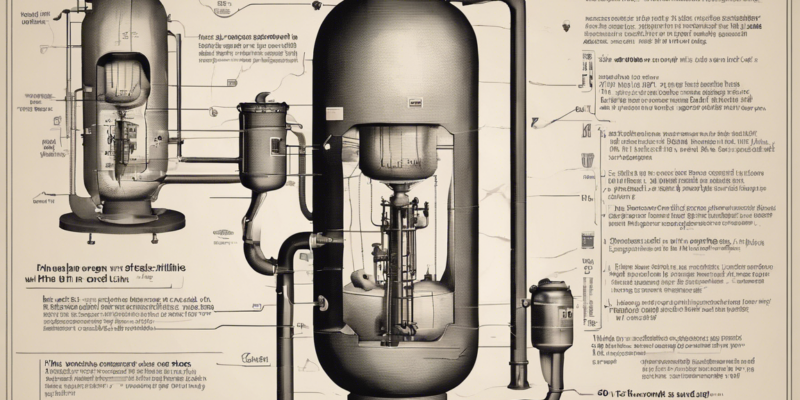Introduction
When we think of gases, we often visualize them filling the containers they are in completely with ease. But have you ever stopped to think about why this happens or how it occurs? In this comprehensive guide, we delve deep into the behavior of gases when they fill a vessel completely. Understanding this phenomenon is crucial in various fields including chemistry, physics, and engineering. Let’s unravel the mysteries of gas behavior!
The Gas Laws
To understand why a gas fills a vessel completely, we need to first take a look at the fundamental Gas Laws that govern the behavior of gases. These laws include Boyle’s Law, Charles’s Law, Gay-Lussac’s Law, and the Ideal Gas Law.
-
Boyle’s Law:
-
States that at constant temperature, the pressure of a gas is inversely proportional to its volume. Mathematically, it can be expressed as: P1V1 = P2V2.
-
Charles’s Law:
-
Asserts that at constant pressure, the volume of a gas is directly proportional to its absolute temperature. This can be represented as: V1/T1 = V2/T2.
-
Gay-Lussac’s Law:
-
States that the pressure of a gas is directly proportional to its absolute temperature when the volume is held constant. Mathematically, it can be shown as: P1/T1 = P2/T2.
-
Ideal Gas Law:
-
Combines Boyle’s Law, Charles’s Law, and Gay-Lussac’s Law into one equation, which is: PV = nRT. Here, P is pressure, V is volume, n is the number of moles of gas, R is the ideal gas constant, and T is temperature.
Gas Behavior in a Vessel
Now that we have a basic understanding of the Gas Laws, let’s explore how gases behave when they fill a vessel completely. When a gas is released into a vessel, it expands to fill the entire volume of the container. This is due to the inherent property of gases to uniformly distribute themselves in the available space.
Key points to consider regarding gas behavior in a vessel:
-
Particle Motion: Gas particles are in constant random motion. When released in a vessel, they move freely in all directions until they collide with the walls of the container.
-
Elastic Collisions: Gas particles undergo elastic collisions with each other and with the walls of the vessel. These collisions ensure that the gas fills the container completely.
-
Pressure Equilibrium: In a closed vessel, the pressure exerted by the gas molecules inside eventually reaches an equilibrium with the pressure exerted by the gas molecules colliding with the walls of the container.
-
Volume Flexibility: Gases do not have a fixed shape or volume. They take the shape of their container and expand or contract to fill the available volume.
Molecular Speed and Distribution
The behavior of gases in a vessel is also influenced by the speed and distribution of gas molecules. Gases consist of a large number of molecules moving at different speeds. The distribution of molecular speeds can be described by the Maxwell-Boltzmann distribution curve.
-
Most Probable Speed: This is the speed at which the maximum number of gas molecules are moving. It represents the peak of the Maxwell-Boltzmann distribution curve.
-
Average Speed: The average speed of gas molecules in a sample is calculated by considering all the individual molecular speeds.
-
Root Mean Square Speed: This is the square root of the average of the squares of the speeds of individual gas molecules. It gives an indication of the speed of a gas sample as a whole.
Understanding the distribution of molecular speeds helps in comprehending how gases behave and fill a vessel completely.
Importance of Gas Behavior Understanding
-
Industrial Applications:
-
Knowing how gases behave in vessels is crucial in industrial processes such as gas storage, chemical reactions, and manufacturing processes.
-
Safety Considerations:
-
Understanding gas behavior is essential for ensuring safety in handling, storing, and transporting gases. Knowledge of pressure and volume relationships is vital in preventing accidents.
-
Environmental Impact:
-
Gases play a significant role in environmental issues such as climate change and air pollution. Understanding gas behavior aids in studying the impact of gases on the environment.
-
Technological Advancements:
-
Advancements in various technologies like refrigeration, air conditioning, and aerospace are driven by a deep understanding of gas behavior and properties.
Frequently Asked Questions (FAQs)
-
Why do gases fill their containers completely?
-
Gases fill their containers completely due to their ability to uniformly distribute themselves in the available space. The random motion of gas particles and elastic collisions lead to the filling of the vessel.
-
What factors influence gas behavior in a vessel?
-
Factors such as temperature, pressure, volume, and the number of gas molecules (moles) affect how gases behave in a vessel.
-
Can gases escape from a sealed container?
-
While gases tend to fill their containers completely, they can escape from a sealed container over time due to factors such as permeability of the container material and pressure differentials.
-
How does temperature affect gas behavior in a vessel?
-
An increase in temperature leads to an increase in the average kinetic energy of gas molecules, causing them to move faster and exert higher pressure on the container walls.
-
What is meant by the term ‘ideal gas’ and the ideal gas law?
-
An ideal gas follows the ideal gas law, which is a theoretical gas that perfectly fits the assumptions of having no intermolecular forces and occupying zero volume. The ideal gas law is represented by PV = nRT.
In conclusion, understanding how gases fill a vessel completely is vital in various scientific, industrial, and practical contexts. By grasping the basics of gas behavior, one can appreciate the intricacies of gas dynamics and their implications in our daily lives.



Comments